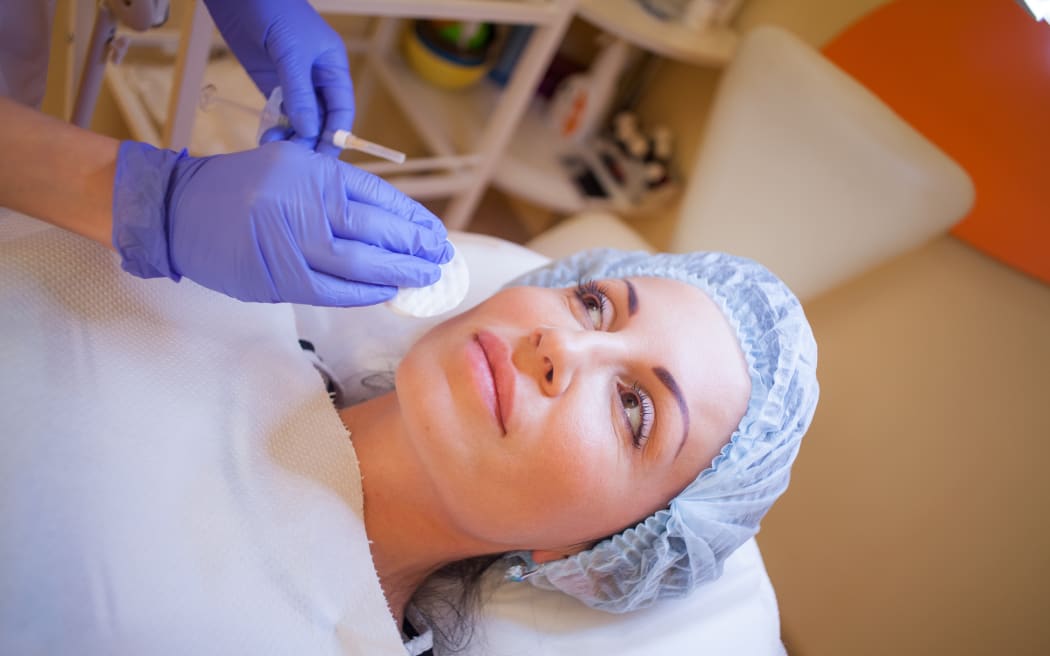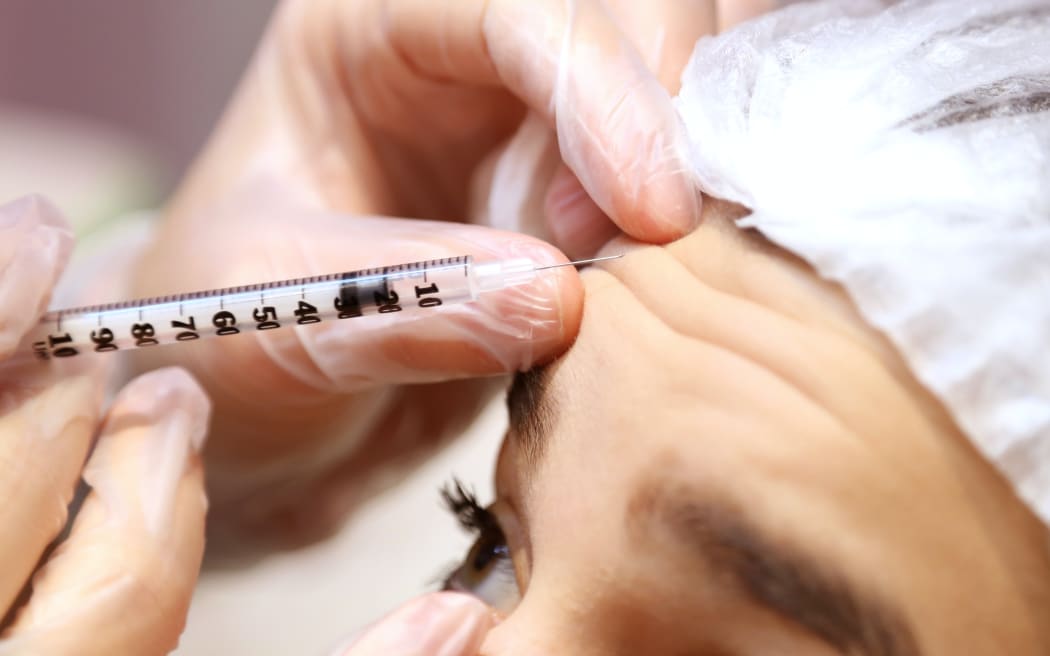
Ready for your close-up? Cosmetic medicine can help people feel better about themselves, says Hawke's Bay doctor Dani Waxman. Photo: 123rf
Is everyone around you looking refreshed and rejuvenated in a way that you can’t quite identify? Chances are, they’re getting a little help from strategically placed injectables like Botox and dermal fillers, says cosmetic medicine expert Dr Dani Waxman.
She tells Afternoons that a lot of people decided they needed treatments after seeing themselves on Zoom meetings during the pandemic.
“They suddenly were seeing how they looked to other people, and how their faces appeared in animation and certain angles, and it made them want to do something about it.”
Some stigma remains about having these treatments, she says, but this is shrinking as they become more common.
Waxman, who works at Central CosMedic in Havelock North, trained in medicine in the UK and moved to New Zealand in 2001. She started getting into cosmetic medicine about 16 years ago, gradually leaving general practice to focus on it fulltime.
“It’s a bit more fun, a little bit less paperwork as well. Patient satisfaction is great on the whole. I do miss some aspects of general practice, but it’s nice to do what I love.”

Dr Dani Waxman says there is still a stigma about cosmetic treatments like Botox. Photo: Supplied
Waxman was going to be a psychiatrist before she became a GP, and says that training has come in handy for assessing patients seeking cosmetic treatments.
She says opting for treatment is a personal choice, similar to deciding to colour your hair or wear makeup.
“Each to their own, I’m not a big advocate of saying ‘you have to have this done’.
“I would feel terrible in myself if somebody felt bad about how they looked after they'd had some treatment with me.”
She says the opposite result occurs: when they think they look better, people feel more confident.
“Somehow because they feel that they look a bit better in how they look on the outside to people, they project a better image to other people as well.”
She joined Afternoons to answer some common question about cosmetic treatments.

This won't hurt a bit: a woman receives a Botox injection to the forehead. Photo: Vlad Egorov for Unsplash
What is Botox, anyway?
Botox is made from Clostridium bacteria. This bacteria produces botulinum toxin that, when used in micro doses, can be safely used for medical or cosmetic treatments. For cosmetic use, it relaxes the muscles that cause wrinkles.
“It's not dangerous at all,” Waxman says. “It's been used for centuries and years even for kids with some spasticity such as cerebral palsy, and things like that just to increase tone in their limbs and what have you, so it is completely safe to use.”
Botox treatment isn’t safe for those who are pregnant or breastfeeding, or who are suffering from major neurological conditions. Waxman says about one percent of the population get a mild headache in the first 24 hours after treatment, while some temporary redness may occur at the injection site. Bruising should be very uncommon, because the practitioner should check that they’re not injecting near veins.
Does it hurt?
“The Botox needles themselves are really tiny,” Waxman says.
“They're the same ones that the insulin-dependent diabetics use to give themselves insulin each day. Then for the dermal fillers, for instance, they've got lidocaine (the stuff that makes you numb at the dentist) that's already in the product. Plus, I use numbing injections and numbing creams to basically to make it as painless as possible, really.”
How often do you have to keep having Botox to maintain the look?
Depending on the product used, Waxman says around four months is about average.
“I see some people that only come, say, every six months because I just want to keep it looking nice and natural and let it wear off for a little bit in between. It’s really a preference and like I said before, if you decide that it's not for you, it's easy enough not to have it done again, without there being any bad effects on your skin or anything like that.”
What’s the ballpark cost?
For a frown line, for example, Waxman would use about 20 units of Botox, for which she charges $440.
Can Botox help with other conditions?
About 15 percent of Waxman’s patients receive Botox for other conditions, including excessive sweatiness and teeth grinding. Botox is approved, but not funded in Aotearoa, as a treatment for chronic headaches and migraines.
“I see quite a few patients for migraine treatment, and migraine relief,” Waxman says.
“It's given to specific trigger points or injections, usually around the neck muscles or even parts of the face where they experience a headache or migraine. And it works really well, generally lasting approximately six months, sometimes up to eight months.”
Does ‘preventative Botox’ stop wrinkles from forming?
While most first-time Botox users are in their mid-30s to 50s, Waxman says there is a trend for younger people to get Botox before they get any deep lines or wrinkles. She’s not convinced that this is a good idea.
“It's not really a treatment that I prefer to do. I think it's nice to have a few lines anyway, to just look natural.”
If you get one treatment of Botox and then decide not to continue will the lines be worse than if you hadn't done it at all?
Not at all, Waxman says.
“Because it’s just a temporary treatment, gradually the lines will slowly reappear. It will take them longer to reappear. to reappear than they would have done if you hadn't had any treatment, but they certainly don't come back worse than they were to begin with, if anything, a little bit softer for longer.”
Can 60-year-olds have Botox, or is it too late?
Waxman says she frequently sees 60-year-olds having Botox, even for the first time. Botox won’t eradicate lines, but it will soften them.
“If people want a little bit more, where they feel that they want the lines to look less obvious or softer after the Botox, that's when dermal fillers can come into play and be used a little bit for volume loss as well. But it's not always necessary.”
Related: Ditching the dye
Related: Calls to tighten rules on cosmetic injectables
Related: What to do about teeth-grinding and jaw-clenching

Pucker up: dermal fillers are used to plump up thinning lips. Photo: Vlad Egorov for Unsplash
What are dermal fillers?
Dermal fillers are used to replace where volume has been lost in the skin, Waxman says, restoring a nice, plump and smooth appearance. They’re made of hyaluron, or hyaluronic acid, which is a natural substance that exists in the human body.
“Basically, from the mid-20s, we lose about one percent of our collagen, or hyaluronic acid, a year. So generally by the age of 50, we’ve lost approximately 40 percent of our skin's collagen content.”
Do fillers stretch your skin so you look all saggy when you stop using them?
No, Waxman says, because dermal fillers stimulate collagen production in the body to some degree. Also, the amount put in is very small, so it just volumises the skin rather than stretching it.
“If somebody were to stop having dermal filler, then gradually the effects of it would go away but it would take a good year to two years.”
What kind of treatment makes your lips look overdone?
Lips “that are coming around the corner before they do” are the result of too much dermal filler being put in the lip, Waxman says. The product migrates above the natural pink border of the lips “because there’s nowhere else to go”.
“And it just it just looks terrible. It looks wrong.”
If this happens and the patient wants to remedy it, Waxman says the application of another product, called Hylase, will dissolve the hyaluronic acid filler and get rid of it completely.
Once you’ve started using Botox and dermal fillers, how hard is it to stop?
Waxman says she’s always honest with patients who occasionally tell her they want more work done.
“I say to people, ‘look, I would say no I to you if I don't think you need any more’. And I often do. People come back and say ‘look, I think I need a little bit more here and here’. I say, ‘well, to be honest, it looks natural as it is. So if I were you, I would just leave it at that, I wouldn't add any more.
“If you're surrounded by other people that are having similar kind of things done, then you see that as your norm, but it's not necessarily… it's good to try and keep that insight and rely on your practitioner to guide you as well to not over-treat you.”
Is there a thing as too much Botox or too many fillers?
Waxman says it’s upsetting when she sees people with frozen, or overfilled faces.
“I think to myself, why was that person allowed to do that? Because surely the person treating them should have been able to say no at some point.”
She’s said no to patients who wanted more dermal filler than she was prepared to give them.
“I'm more than happy to do that. If I do treat them, it's kind of a banner advertisement for me. If I'm going to make somebody look overtreated, it wouldn't feel good.”
How do you identify a reputable practitioner?
The New Zealand Society for Cosmetic Medicine has an online list of all the doctors registered in Aotearoa, who have all had two years’ training in cosmetic medicine on top of their registration as GPs.
Nurses are required to be supervised by a doctor practicing in the field.
“So it’s a good question to ask, if you don't know who their supervising doctor is, ask who they are and whether they are on site, or are they remotely supervising them from another location.”
You have to be a doctor or a nurse to administer Botox, because it’s a prescription medicine. However, dermal fillers are currently classed as ‘a medical device’, so anyone can buy and administer them.
Waxman says she hopes New Zealand will soon follow the example of the UK, which has stricter controls on the use of dermal fillers.
In general terms, the best recommendation is word-of-mouth, Waxman says: in other words, if you see someone who looks fresher and well-rested but you can’t quite figure out how, ask them who they’re getting treatment from.
“Then they can be assured that they’re not going to end up looking plastic, or frozen, or over-filled.”

